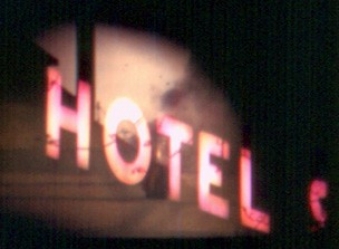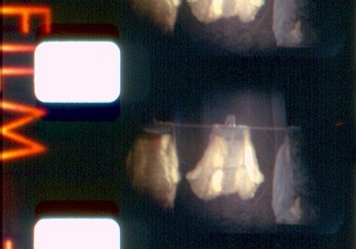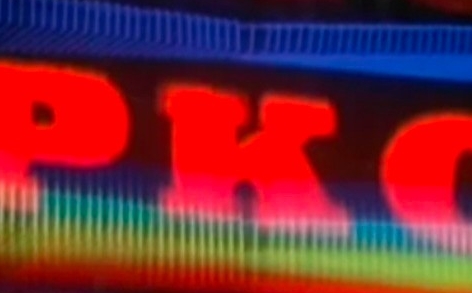Banner stills L to R: Litany of Happy People, courtesy Slovene Cinematheque;
Death of Metalosaurus, courtesy Igor Toholj; and Game, courtesy Slovene Cinematheque
Pression
Ljubomir Šimunić, Serbia, 1970–75, 8 mm transfer to Blu-ray, 15 minutes

Still from Pression, courtesy Alternative Film Archive
Academic Film Center, Belgrade
Ljubomir Šimunić (b. 1942) is an outsider’s outsider, though his work has garnered some attention in recent years. In the 1970s, he began making amateur films on his own, without the support of the amateur film clubs popular across Yugoslavia, and showed them only to friends in private rooms and apartments. To date, his films, of which Pression is the earliest, have been shown publicly only a handful of times, and the screening of Pression in Washington marks Šimunić’s US premiere.[1]
Šimunić’s working method is markedly different from that of any other amateur presented in this series. His films are, like many shot with 8 mm cameras, all edited in-camera—for Pression, Šimunić used a Normal 8 Kodachrome. Unlike most amateur films, however, which were usually made very quickly, Šimunić’s were shot over longer periods of time, sometimes years, with Pression taking the longest of his five films to make. Working with his friend Dragan Taubner, the filmmaker used color film reels that could record approximately four minutes of footage each and which he kept in a refrigerator for months or years, painstakingly double exposing select frames over time to achieve resonant overlappings. These combined, on the one hand, footage of everyday people and events around Belgrade shot on foot and from a car during day and night and, on the other hand, garish spectacles, movies, and ads, both Yugoslav and Western, that he shot from a flickering TV screen.[2] According to Šimunić, his interest in double exposure was “an attempt to prove in and by art the current scientific facts which [claim] that only a small part of [the] human brain is exposed and able to accept [the flow of] information."[3]”

Still from Pression, courtesy Alternative Film Archive
Academic Film Center, Belgrade
The result, as seen in Pression, is at once insightful and disorienting, unsettling and mesmerizing. It offers a combination of the filmmaker’s private obsession—Šimunić enjoyed making voyeuristic erotica and in his film Summer Dreams (1976–78) even included footage from commercial pornography[4]—and prescient comment on the way popular culture enters even the most reclusive life to feed into its desires. When screening his films, Šimunić infused the dizzying array of shifting images with additional energy by using a sound track of contemporary music; in Pression, the songs are 1970s disco and funk tunes recorded by a friend onto cassette tape from a New York radio station (WBLS) along with the dj’s commentary. Thus combining sound and images, Šimunić himself seems to have treated his films less as fixed works and more as environmental projections, which he sometimes slowed down and projected at four or eight, rather than 16, frames per second to change the atmosphere among his friends. Even though the digitzed version of the film shown in this series retains the “proper” 18 fps rate, it still allows one to start grooving and let one’s mind wander as the film’s wild juxtapositions make unexpected connections between ideas with a rapidity that no traditional form of narrative could match. — Ksenya Gurshtein
With thanks to Ljubomir Šimunić, David Šimunić, Dejan Sretenović, and Miodrag Milošević, Head of the Academic Film Center at the Student City Cultural Center (Akademski Filmski Centar Dom Kulture Studentski Grad), Belgrade, and to the entire staff of the AFC for their assistance with research and help in making a screening of the film possible in Washington. With special thanks also to the Film Center Serbia (Filmski Centar Srbije), Belgrade, which generously sponsored the digital restoration of this film shortly before its screening in Washington.
Centre (Centrum)
Kazimierz Bendkowski, Poland, 1973, 35mm, 5 minutes 20 seconds

Still from Centre, courtesy Filmoteka Muzeum
Kazimierz Bendkowski’s (b. 1948) characteristically abstract work explores the limits of sound and image montage. Filmed at night in the heart of Warsaw—though at times, the location could be mistaken for almost any Western urbanscape of the time—Centre (Centrum) cuts up a panorama of lights and neon signs with sounds from the street, creating a rhythmic panoply of noises and textures.[5] Prismatic effects of bright lights, lenses, and various close-ups of kinetic neon signs—including the tell-tale PKO for Bank Polski—form a sweep of red-green-blue intensity matched by the highly manipulated sound track. Layers of inaudible speech and the sound of traffic and crowds are deftly melded with electronic spectrums and disorienting echo effects. Ultimately, the film cycles back, returning to the night street scene with which it began.
Trained as a photographer, Bendkowski was a founding member of the Workshop of the Film Form. In 1982, he emigrated from Poland to Germany and taught film and animation at the Kunsthochschule in Kassel until his retirement in 2010. He currently lives in Warsaw. — Joanna Raczynska
With thanks to Łukasz Mojsak, Filmoteka Muzeum, Museum of Modern Art in Warsaw for his assistance, and Weronika Czołnowska, Polish National Film, Television and Theatre School in Lodz for making a 35 mm print of this film available for the screening in Washington.
1. Previously, the films have been shown in Hyères (1979), where they received the Critics’ award; London (in 1977 or 1978), Belgrade (at the Alternative Film Festival in 1982 and 2011), Ljubljana (1983), Thessaloniki (2009), and Zurich at the Video Ex Festival (2013). This information comes to me from Miodrag Milošević, Head of the Academic Film Center at the Student City Cultural Center (Akademski Filmski Centar Dom Kulture Studentski Grad), Belgrade, and from Vassily Bourikas’ program notes for a Šimunić retrospective that was part of the Experimental Forum at the 2009 Thessaloniki International Film Festival. (back to top)
2. The abundant Western content—such as scenes from films with Western icons, including Marilyn Monroe and Ann Margaret—is very evident in the footage shot from the television. Its presence, however, should not be surprising given that “existing data suggest that in the early 1970s, as much as 80% of all imported programs broadcast by TV Belgrade came from outside of the socialist bloc and 40% from the U.S. alone.” (back to top)
3. Ljubomir Šimunić untitled autobiographical sketch appeared in the Slobodan Šijan’s self-published film zine Filmski letak in 1977. I am grateful to Miodrag Milošević, Head of the Academic Film Center at the Student City Cultural Center (Akademski Filmski Centar Dom Kulture Studentski Grad), Belgrade, for sharing a scan of this document with me. (back to top)
4. Prurient voyeurism was not uncommon among Eastern European amateur filmmakers, who, being most often male, seem as a group almost fixated on the transgressive act of filming the female body in a sexualized way that was largely expunged from socialist popular culture. Šimunić is no exception here. In the biographical sketch cited above, he writes about himself, “Being a voyeur in his nature he grabbed the camera as a weapon aimed at attaining . . . mental violence. The Wo-Man in action of Brain-Strip. Unbuttoned dresses, panties worn on naked body, stretched thighs. the art melts into erection.” (back to top)
5. Though Centre is a deeply apolitical film, from today’s perspective, the cityscape it depicts in experimental ways speaks to the broader social history of changing attitudes toward consumerism and the West in Eastern Europe from the late 1950s on. As can be seen from the writings of the historian David Crowley, neon signs, which were introduced in Warsaw in the late 1950s, bore a lot of symbolic meaning: “The changing appearance of the city was a product of the party’s promises to improve standards of living in the face of a storm of criticism following Stalin’s death. The modish sensibility had its foremost architectural expression in the wave of cafes and bars which were newly opened or refurnished in the second half of the 1950s. Whereas abstract art on the walls and neon on the facades of these leisure sites were clear signs of a new attitude toward the satisfaction of previously suppressed appetites, much of this modernization was ‘surface-deep’ in a literal sense.” David Crowley, “Paris or Moscow?: Warsaw Architects and the Image of the Modern City in the 1950s,” in Imagining the West in Eastern Europe and the Soviet Union, ed. György Péteri (Pittsburgh, 2010), 124.[KS] (back to top)



